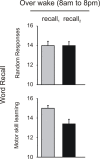Off-line processing: reciprocal interactions between declarative and procedural memories
- PMID: 17898218
- PMCID: PMC6673170
- DOI: 10.1523/JNEUROSCI.2799-07.2007
Off-line processing: reciprocal interactions between declarative and procedural memories
Abstract
The acquisition of declarative (i.e., facts) and procedural (i.e., skills) memories may be supported by independent systems. This same organization may exist, after memory acquisition, when memories are processed off-line during consolidation. Alternatively, memory consolidation may be supported by interactive systems. This latter interactive organization predicts interference between declarative and procedural memories. Here, we show that procedural consolidation, expressed as an off-line motor skill improvement, can be blocked by declarative learning over wake, but not over a night of sleep. The extent of the blockade on procedural consolidation was correlated to participants' declarative word recall. Similarly, in another experiment, the reciprocal relationship was found: declarative consolidation was blocked by procedural learning over wake, but not over a night of sleep. The decrease in declarative recall was correlated to participants' procedural learning. These results challenge the concept of fixed independent memory systems; instead, they suggest a dynamic relationship, modulated by when consolidation takes place, allowing at times for a reciprocal interaction between memory systems.
Figures








References
-
- Brashers-Krug T, Shadmehr R, Bizzi E. Consolidation in human motor memory. Nature. 1996;382:252. - PubMed
-
- Cohen NJ, Squire LR. Preserved learning and retention of pattern-analyzing skill in amnesia: dissociation of knowing how and knowing that. Science. 1980;210:207–210. - PubMed
-
- Curran T. Higher order associative learning in amnesia: evidence from the serial reaction time task. J Cogn Neurosci. 1997;9:522–533. - PubMed
